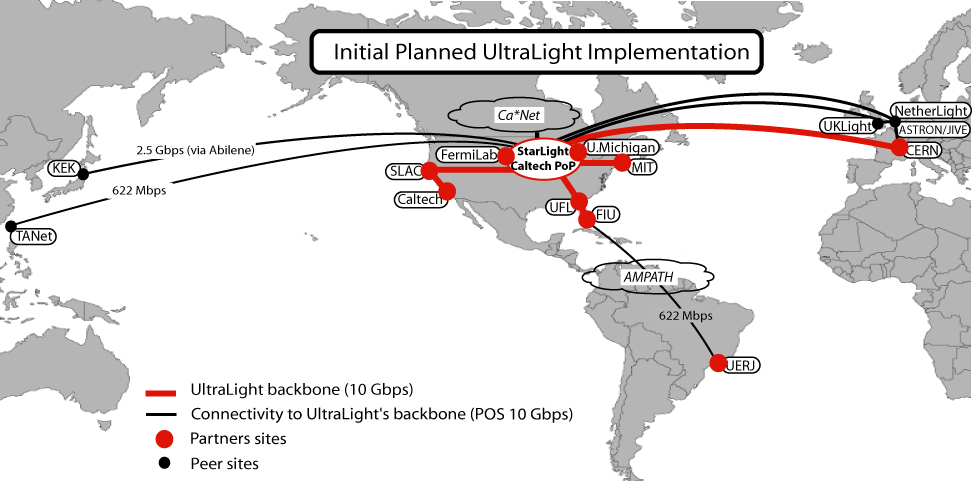UltraLight: An Ultra-scale Optical Network Laboratory for Next Generation Science

Proposal
A complete document (HTML, Word, PDF) that describes the UltraLight proposal, and includes all the supporting material, suitable for distribution to external institutes, vendors, etc. (33 pages).
Summary (also reproduced below) (PDF, Word)
List of Letters of Support (PDF)
Leveraged Facilities (PDF, Word)
Summary
Intellectual Merit: We propose to develop and deploy UltraLight, the first integrated packet switched and circuit switched hybrid experimental research network, to meet the data intensive needs of next generation science, engineering and medical applications, and to drive the development of a new generation of globally Grid-enabled distributed systems. A unique feature of the UltraLight concept is its end-to-end monitored, dynamically provisioned mode of operation, with agent-based services spanning all layers of the system, from the optical cross-connects to the applications. Our experimental network will focus on three “flagship” application areas: (1) particle physics experiments exploring the frontiers of matter and spacetime (LHC), (2) astrophysics projects studying the most distant objects and the early universe (e-VLBI), and (3) medical teams distributing high resolution real-time images. These disciplines collectively present fundamental challenges in distributed terascale data access, processing and analysis that cannot be met by existing network infrastructures.
The UltraLight project will develop a global optical network testbed, and
scalable distributed storage and Grid systems, integrating and leveraging the
major facilities of LHCNet and DataTAG with transcontinental 10 Gbps
wave-lengths from National Lambda Rail, in research partnership with Starlight,
UCAID, Cisco and Level(3). Additional trans- and intercontinental wavelengths in
our partner projects TransLight, Netherlight, UKlight, AMPATH, and CA*Net4 will
be used for network experiments on a part-time or scheduled basis. This will
give us a core experimental network wi130cipal nodes in California (Caltech and
SLAC), Chicago (StarLight and Fermilab), Florida (U. Florida and FlU), Michigan
(U. Michigan), Massachusetts (MIT/Haystack), CERN, Amsterdam and the United
Kingdom (UC London), with extensions across Abilene, to Taiwan and Japan in
Asia, and across AMPATH to South America. The foundation of UltraLight will be a
very flexible network fabric, high performance network-resident server clusters,
“ultrascale” protocols designed to support stable high performance, MPLS for
fair-shared use of networks at multi-Gbps speeds, and intelligent software
agents in the MonALISA monitoring framework that will manage network operations
and provide an interface between the flagship applications and the ultrascale
protocol stack to optimize performance.
UltraLight will operate in a new “hybrid” mode. The principal 10G wavelength
interconnecting the core sites will accommodate a diverse traffic mix resulting
from the flagship applications, using packet switching. Monitoring agents will
handle network flows exceeding the capacity of the core wavelength by
dynamically routing the traffic over alternate paths, using the multiply
connected topology and the multi-wavelength nature of UltraLight (across the
Atlantic and NLR in particular), to transport TByte to PByte datasets while
simultaneously delivering multi-Gigabyte images in seconds. A principal aim of
UltraLight will be to apply its results on network operation, dynamic
provisioning, optimization and management broadly, and to develop standards that
will serve many fields.
Broad Impact: Our international optical network testbed will span key core sites in the US and Europe, with a growing set of extensions to Asia and South America. We will deploy “ultrascale” network protocols such as FAST TCP that are capable of stable, fair-shared operation at 1-10 Gbps and eventually higher speeds, and follow a systematic development path addressing issues of protocol fairness and end-to-end performance among disk servers. This will enable us to progressively deploy the results from each development cycle of our R&D across the world’s major production networks, including Abilene, National Lambda Rail, and TeraGrid in the US, and GEANT in the EU, as well as major international links serving the scientific communities in South America, Japan, and Korea.
UltraLight will have several long-term achievements: (1) Enable a new generation
of scientific and medical discoveries by creating a dynamic, agent-driven
networking infrastructure supporting distributed data intensive re-search; (2)
Integrate our results with emerging data-intensive Grid systems, to drive the
next generation of Grid developments, worldwide monitoring systems and new modes
of collaborative work; (3) Collaborate with groups leading the development of
optical switching technologies to understand the relative roles of
circuit-switching and packet-switching in support of major scientific
applications; and (4) Apply our results to a broader set of applications, from
new biomedical applications, to high-end real-time visualization of large-scale
climatology datasets, bringing the benefits of advanced networks to science and
society, while transforming the evolution of the Internet.
Education and Outreach: We will provide students with innovative educational outreach opportunities that utilize the groundbreaking work of the project, and leverage existing programs such as FIU’s CHEPREO and CIARA projects to provide recruitment and infrastructure. The UltraLight proposal directly supports E&O activities including development of EIN applications, participation in experiments and deployments of infrastructure, and networking internships at participating institutions, through an allocation of 4% of the overall budget. These opportunities will provide training and inspiration for the next generation of scientists and network engineers.